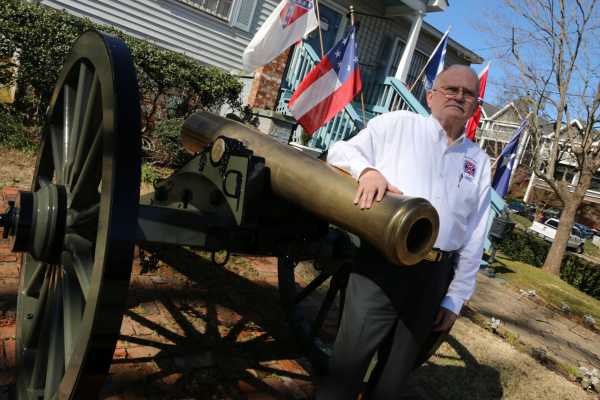
Prepping for a return visit to the attractive and prospering city of Greenville, South Carolina, I grabbed the only South Carolina travel book in our library system. An entry in the Moon series, it reassured Northern visitors that Greenville “is not populated by backward Bible-thumping bigots.”
And smug cosmopolitans wonder why the rest of us hate their guts!
Advertisement
Greenville, whose favorite sons are the Jacksons (Shoeless Joe and Jesse), was the site of the last concert that Lynyrd Skynyrd, the free birds of Southern rock, played before the band’s plane went down on October 20, 1977. One of Skynyrd’s better songs, “All I Can Do is Write About it,” protests the paving over and homogenization of the South. Lead singer Ronnie Van Zant pleads, “Lord take me and mine before that comes.” The Lord, or a drunken pilot or defective plane, did as Ronnie wished. But pavers gonna pave.
Prominently absent from the Moon guide as well as the maps distributed by the city’s tourism promoters was any mention of the Museum and Library of Confederate History, which is the kind of filiopietistic throwback that makes New South boosters cringe.
Chamber of Commerce be damned, I dropped by the museum, which is operated by the Sons of Confederate Veterans and tucked away in a modest flag-festooned house (though I didn’t see Old Glory) in the Pettigru Historic District.
Upon entry, I was greeted by a man whose accent was redolent of the days before the Greenville region became the North American headquarters of BMW and Michelin.
“I’m Larry Waddell,” he said, extending his hand. I shook it.
Advertisement
“Bill Kauffman.”
“You from around here?”
“No, I’m from New York.” I hastily added, “Towards Buffalo way.”
“Buffalo,” he said with a vague look of distaste, as if I’d said, “I’m a Unitarian poet from Boston.”
“Another damnyankee. You’ll need a green card.”
And he handed me a green card, which was bannered:
Confederate States of America
Immigration and Naturalization Service
The bearer of this card, it went on, “is a citizen of the Northern United States and has been granted the privilege of living within the Confederacy. Privilege has been granted by virtue of marriage to a Southerner, adoption, or by exhibiting a willingness to forgo inbred damnyankeeness. Reverting back to the damnyankee way of life will automatically result in the voiding of this card and immediate deportation across the Potomac.”
Since I’m a Yorker, not a Yankee, I avoided expulsion.
The Confederate Museum, which Mr. Waddell says receives “no support” from the city, is item-rich, with captions that make no pretense of objectivity. The Palmetto State was the first to secede from the Union, and there are no regrets, no apologies, and no allowances of “on the other hand” in this CSA redoubt on Boyce Avenue.
I saw rifles and revolvers, swords and sovereignty flags, amputation instruments (including a saw embedded in bone) and wooden legs, Confederate money, and enough images of Robert E. Lee and Jefferson Davis to make an Oberlin sophomore hyperventilate. The photographs of various Johnny Rebs and generals from South Carolina included one of General States Rights Gist. Born in 1831 in, ironically, Union, South Carolina, States Rights Gist had a father who admired John C. Calhoun, who at the time was locked in a fight with Andrew Jackson over, well, states’ rights. States Rights, upper case, died in 1864, shot through the heart at the Battle of Franklin, Tennessee.
Subscribe Today Get weekly emails in your inbox Email Address:
Pictures of black Confederates and their descendants also line the walls, with descriptive text emphasizing their Southern patriotism. The museum frames the war as a sectional conflict in which the matter of slavery was secondary. I’ve never bought that line, but how far we have fallen if those who offer alternative interpretations of what Gore Vidal called “the great single tragic event that continues to give resonance to Our Republic” are ostracized.
My strongest sympathies lie with the Christian anarcho-abolitionists, many from my neck of the woods, who sought to dissolve the South’s peculiar institution by moral suasion in the 1830s and later by defying the Fugitive Slave Act with “personal liberty” laws. They were doing the Lord’s work. But even compensated emancipation—paying slave-owners to free their human chattel—would have been preferable to the four-year slaughterhouse that left 700,000 boys and men dead, millions bereft, the lower half of the country prostrate and impoverished, and the newly freed slaves largely propertyless.
Eugene Genovese, the great Marxist historian of slavery and the South, said that no one should be asked to spit on the graves of his ancestors. The old boys manning the Confederate Museum in Greenville sure don’t.

This article appears in the July/August 2022 issue
Subscribe Now Advertisement
Sourse: theamericanconservative.com






